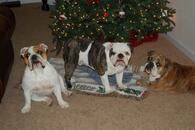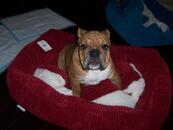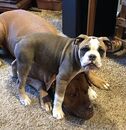Hi I have a five year old female bulldog who is my best friend about six months ago right beside her tail she developed what looked like a cut for four months I would watch it bleed then puss would come out not knowing what it was I took her to the vet and found out she had perianal fistula I don't have the money for proper medicane right now so I went to my doctor said I have it cause my meds are free he gave me Diltiazem does anybody know if that will work? She also has developed like bumps on her vulva does anybody know anything that can help?
You are using an out of date browser. It may not display this or other websites correctly.
You should upgrade or use an alternative browser.
You should upgrade or use an alternative browser.
My Bulldogs has perianal Fistula please help
I really cant help you here but I will tag some that should be able to help
Hi I have a five year old female bulldog who is my best friend about six months ago right beside her tail she developed what looked like a cut for four months I would watch it bleed then puss would come out not knowing what it was I took her to the vet and found out she had perianal fistula I don't have the money for proper medicane right now so I went to my doctor said I have it cause my meds are free he gave me Diltiazem does anybody know if that will work? She also has developed like bumps on her vulva does anybody know anything that can help?
I'm so sorry you're going through this with Daisy. I don't have any experience with this with dogs, but I do know someone who had an anal fissure, and I know that they are pretty painful. Apparently they can be caused from being constipated and straining, and they are slow to heal and are also prone to coming back. I don't know if that is the case with dogs or not, and I'm not sure if they are the same thing or not. Many medications, supplements, and creams, etc that are safe for humans are also safe for dogs. I hope the medication works and she feels better soon. You can try sitting her in the bathtub with warm water and Epsom salts, it might be soothing to her, and will help heal the fissure and infection. You can also put some Polysporin on it.
Here is a link to a great Article by one of our members JeannieCo on The Proper way to clean ears, nose ropes, paws, tail pockets and vulva.
English Bulldog News Forums - The Proper Way to Clean Ears, Nose Ropes, Folds, Paws, Tail Pockets and Vulva
Hi I have a five year old female bulldog who is my best friend about six months ago right beside her tail she developed what looked like a cut for four months I would watch it bleed then puss would come out not knowing what it was I took her to the vet and found out she had perianal fistula I don't have the money for proper medicane right now so I went to my doctor said I have it cause my meds are free he gave me Diltiazem does anybody know if that will work? She also has developed like bumps on her vulva does anybody know anything that can help?
I'm so sorry you're going through this with Daisy. I don't have any experience with this with dogs, but I do know someone who had an anal fissure, and I know that they are pretty painful. Apparently they can be caused from being constipated and straining, and they are slow to heal and are also prone to coming back. I don't know if that is the case with dogs or not, and I'm not sure if they are the same thing or not. Many medications, supplements, and creams, etc that are safe for humans are also safe for dogs. I hope the medication works and she feels better soon. You can try sitting her in the bathtub with warm water and Epsom salts, it might be soothing to her, and will help heal the fissure and infection. You can also put some Polysporin on it. Bulldogs are prone to tail pocket infections and you need to keep the area clean to avoid them. The tail pocket is located just under the tail, and is a pocket where dirt, hair, and feces gets stuck and then gets sore and infected. You have to clean this area out on a regular basis with a baby wipe and then keep it clean and dry.
A perianal fistula is a severe lesion that develops around a dog’s anus. A fistula is an abnormal pathway from something inside the body to the surface of the body. “Perianal” simply means the area around the anus.
In perianal fistula disease, there is often more than one lesion. The result is chronic, persistent draining ulcers that are very painful for the dog.
Perianal fistula disease is also known as anal furunculosis.
[h=2]How Perianal Fistulas Occur[/h]In perianal fistula disease, there is often more than one lesion. The result is chronic, persistent draining ulcers that are very painful for the dog.
Perianal fistula disease is also known as anal furunculosis.
It is thought that perianal fistulas result when sweat and oil glands in and around the anus become inflamed and infected. Abscesses form, break open, and drain. Over time, there’s probably also an autoimmune component where the dog’s body begins to overreact to the inflammation, which greatly exacerbates the condition.
The area under a dog’s tail and around the anus is warm, moist and loaded with bacteria, which is the perfect environment to brew an infection. The anal glands are sometimes involved, but not always.
[h=2]Causes of the Disorder and At-Risk Breeds[/h]The area under a dog’s tail and around the anus is warm, moist and loaded with bacteria, which is the perfect environment to brew an infection. The anal glands are sometimes involved, but not always.
Because certain breeds are more prone to the condition than others – including Labrador Retrievers, Irish Setters, Old English Sheepdogs, Border Collies, Bulldogs, Spaniels, and in particular the German Shepherd – it’s assumed there’s a hereditary component to the disorder.
Interestingly, it could also be partly a conformation issue. Since German Shepherd dogs have a broad tail base and carry their tails very low and close to their bodies, this could in theory result in poor ventilation of the anal area, trapping fecal material next to the anal folds. German Shepherds also have more of a certain type of sweat gland than other breeds called apocrine sweat glands. Apocrine sweat glands produce a smelly, oily sweat rather than a watery sweat in the anal area.
Allergic skin conditions may also be a factor. Managing allergic symptoms, including food allergies, can greatly help improve perianal fistulas.
Perianal fistulas are more commonly seen in middle-aged and older dogs. About twice as many males are affected as females. And about 80 percent of the time, the dog is a German Shepherd.
[h=2]Symptoms and Diagnosis of Perianal Fistulas[/h]Interestingly, it could also be partly a conformation issue. Since German Shepherd dogs have a broad tail base and carry their tails very low and close to their bodies, this could in theory result in poor ventilation of the anal area, trapping fecal material next to the anal folds. German Shepherds also have more of a certain type of sweat gland than other breeds called apocrine sweat glands. Apocrine sweat glands produce a smelly, oily sweat rather than a watery sweat in the anal area.
Allergic skin conditions may also be a factor. Managing allergic symptoms, including food allergies, can greatly help improve perianal fistulas.
Perianal fistulas are more commonly seen in middle-aged and older dogs. About twice as many males are affected as females. And about 80 percent of the time, the dog is a German Shepherd.
Symptoms of the condition include straining to defecate, perianal pain and bleeding, constipation or diarrhea, lack of appetite, feeling the need to poop but the bowel is empty, biting and licking the anal area, a bad smelling discharge, lethargy, and changes in temperament.
You may also be able to see the lesions in your dog’s anal area. They can range from very small to over several inches in diameter and can extend up the tail. Some dogs with the condition feel pain just trying to move their tail.
Diagnosis of perianal fistula disease involves considering the age and breed of the dog, taking a history of symptoms, and performing a physical exam of the dog’s anal area, including a rectal exam. Sometimes a skin biopsy is done to rule out similar appearing conditions such as cancer of the anus, a hyperplastic anus, perianal adenoma (which is a benign tumor), or an anal sac rupture.
Depending on the severity of the condition, your dog may need sedation in order to be examined. This can actually be the kinder approach, because the dog may be feeling overwhelming pain, and just lifting his tail can be excruciating for him.
[h=2]Treatment Options[/h]You may also be able to see the lesions in your dog’s anal area. They can range from very small to over several inches in diameter and can extend up the tail. Some dogs with the condition feel pain just trying to move their tail.
Diagnosis of perianal fistula disease involves considering the age and breed of the dog, taking a history of symptoms, and performing a physical exam of the dog’s anal area, including a rectal exam. Sometimes a skin biopsy is done to rule out similar appearing conditions such as cancer of the anus, a hyperplastic anus, perianal adenoma (which is a benign tumor), or an anal sac rupture.
Depending on the severity of the condition, your dog may need sedation in order to be examined. This can actually be the kinder approach, because the dog may be feeling overwhelming pain, and just lifting his tail can be excruciating for him.
Traditional treatment of perianal fistulas involves the use of antimicrobials (depending on what the culture and sensitivity test shows), stool softeners to help reduce pain when the dog defecates, immunosuppressive agents, surgery, food changes, and of course, supplements. Because there can be multiple causes for the disease, it’s not unusual for veterinarians to attempt several different treatment methods simultaneously.
Surgery is usually reserved for dogs for whom medical management hasn’t worked. It’s a difficult procedure because there are so many nerves and blood vessels in that area, and often the ulcers are very deep. Thankfully, I’ve never had to recommend surgery for any of my patients with perianal fistulas, and I’m hoping I never will.
Treatment starts with clipping the hair away from the anus, cleaning the area with an antiseptic solution, then flushing with large amounts of water. I recommend that owners disinfect their dog’s perianal area twice daily with a potent natural cleanser. At my practice, I use a solution called Lacerum® Wound Cleanser. This step, in my opinion, is too often overlooked in managing perianal fistulas.
Vets tend to rely on drugs to disinfect when manual cleaning is more effective. Oral medications can never measure up to manual disinfection.
I also strongly recommend a grain-free, novel protein diet for all animals suffering from this condition. I have found removing grains and pro-inflammatory carbohydrates, including potatoes, from these patients’ diets notably improves their symptoms long-term.
I also recommend a protocol of Chinese herbs, curcumin, nirgundi oil (applied topically to the anus), the herb triphala guggul (given orally), and laser therapy, along with an immune-balancing protocol. Dogs with perianal fistulas should not receive vaccinations.
The earlier perianal fistula disease is diagnosed and treated, the better the outcome for the dog. Recurrence is unfortunately very common, and fecal incontinence often develops in severe cases, especially those requiring surgery.
My suggestion is to find a holistic veterinarian who has experience treating perianal fistulas to help improve your dog’s quality of life and overall well-being long-term while managing this chronic and frustrating disorder.
Surgery is usually reserved for dogs for whom medical management hasn’t worked. It’s a difficult procedure because there are so many nerves and blood vessels in that area, and often the ulcers are very deep. Thankfully, I’ve never had to recommend surgery for any of my patients with perianal fistulas, and I’m hoping I never will.
Treatment starts with clipping the hair away from the anus, cleaning the area with an antiseptic solution, then flushing with large amounts of water. I recommend that owners disinfect their dog’s perianal area twice daily with a potent natural cleanser. At my practice, I use a solution called Lacerum® Wound Cleanser. This step, in my opinion, is too often overlooked in managing perianal fistulas.
Vets tend to rely on drugs to disinfect when manual cleaning is more effective. Oral medications can never measure up to manual disinfection.
I also strongly recommend a grain-free, novel protein diet for all animals suffering from this condition. I have found removing grains and pro-inflammatory carbohydrates, including potatoes, from these patients’ diets notably improves their symptoms long-term.
I also recommend a protocol of Chinese herbs, curcumin, nirgundi oil (applied topically to the anus), the herb triphala guggul (given orally), and laser therapy, along with an immune-balancing protocol. Dogs with perianal fistulas should not receive vaccinations.
The earlier perianal fistula disease is diagnosed and treated, the better the outcome for the dog. Recurrence is unfortunately very common, and fecal incontinence often develops in severe cases, especially those requiring surgery.
My suggestion is to find a holistic veterinarian who has experience treating perianal fistulas to help improve your dog’s quality of life and overall well-being long-term while managing this chronic and frustrating disorder.
- Jul 28, 2011
- 48,596
- 3,690
- Country
- USA
- Bulldog(s) Names
- Chelios (Frenchie), Cubby (Frenchie) Nitschke (2004-2011) Banks (2005-2014) and Lambeau (2014-2024)
Welcome to EBN ..... sorry you and your baby are going through all this. I have no experience, but based on all the great info Monica posted.... I would add some pur pumpkin to her food or give a small amount of Metamucil to keep her bowels moving and stool soft, it will help lessen the pain of 'going' and hopefully not cause more damage
- Thread Starter
- Thread starter
- #7
Thanks for all the info. This is a terrible thing to happen to your dog it never stops no matter how I clean it and how I stay on top of it. It bothers her but not like crazy I have another frenchton that always tries to clean it which I am not sure if that's bad? I try and keep her from doing it but its almost impossible to stop. It's hard on me cause she's gotten me threw a super hard point in my life and the fact I feel helpless its always draining blood or puss its wierd cause it doesn't get worse or better so.etimes it heals but then blood builds up underneath it and I pop it and let it drain I find it doesn't constibate her or mess up how much she's eating. This is literally the most loyal loving protective loving bulldog on the planet I need for this to go away or not impact her health cause if something happens to her I couldn't deal with it is give her my heart if I could 
Similar threads
- Replies
- 3
- Views
- 822
- Replies
- 20
- Views
- 2K




